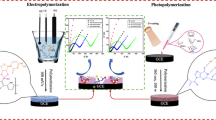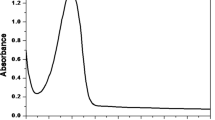Abstract
Evaluation of electrochemical behavior of 5-type phosphodiesterase inhibitory drugs is of major concern since they have been added illegally as adulterants in dietary supplements. Then, for the first time, the solid-sate electrochemistry of sildenafil and tadalafil is described using voltammetry of immobilized microparticles (VIMP). An electrochemical cell was designed and printed in a fused deposition modeling (FDM)-based 3D printer for VIMP measurements. The 3D-printed cell designed with a distance of 5 mm between the working and reference electrode presented better voltammetric response and decrease in the uncompensated resistance of the electrochemical system. Cyclic and square wave voltammograms of the individual compounds were recorded in a paraffin-impregnated graphite electrode in contact with 0.01 mol L−1 H2SO4. The electrochemical oxidation/reduction products were characterized by Raman spectroscopy and scanning electron microscopy (SEM). Different voltammetric responses were detected for the solid compounds depending on the solubility of the parent compound and their products of oxidation/reduction. Moreover, significant crystal re-structuring was also observed after voltammetric scan of the solid compounds. Under optimized conditions, sildenafil and tadalafil could be electrochemical identified and distinguished in dietary supplements.










Similar content being viewed by others
References
Skalicka-Woźniak K, Georgiev MI, Orhan IE (2017) Adulteration of herbal sexual enhancers and slimmers: The wish for better sexual well-being and perfect body can be risky. Food Chem Toxicol:108355–108364
Kass DA, Champion HC, Beavo JA (2007) Phosphodiesterase type 5: Expanding roles in cardiovascular regulation. Circ Res Aha 101:1084–1095
Rocha T, Amaral JS, Oliveira MBPP (2016) Adulteration of dietary supplements by the illegal addition of synthetic drugs: A Review. Compr. Rev. Food Sci Food Saf 15:43–62
Champagne AB, Emmel KV (2011) Rapid screening test for adulteration in raw materials of dietary supplements. Vib Spectrosc 55:216–223
Carvalho LM, Martini M, Moreira APL, Lima APS, Correia D, Falcão T, Garcia SC, Bairros AV, Nascimento PC, Bohrer D (2011) Presence of synthetic pharmaceuticals as adulterants in slimming phytotherapeutic formulations and their analytical determination. Forensic Sci Int:2046–2012
Muratt DT, Müller LS, Dal Molin TR, Viana C, Carvalho LM (2018) Pulsed amperometric detection of pharmacologic adulterants in dietary supplements using a gold electrode coupled to HPLC separation. Anal Methods 10:2226–2233
Müller LS, Muratt DT, Dal Molin TR, Urquhart CG, Viana C, Carvalho LM (2016) Analysis of pharmacologic adulteration in dietary supplements by capillary zone electrophoresis using simultaneous contactless conductivity and uv detection. Chromatographia 81:689–698
Paíga P, Rodrigues MJE, Correia M, Amaral JS, Oliveira MBPP, Delerue-Matos C (2017) Analysis of pharmaceutical adulterants in plant food supplements by UHPLC-MS/MS. Eur J Pharm Sci 99:219–227
Özkan SA, Uslu B, Zuman P (2004) Electrochemical oxidation of sildenafil citrate (Viagra) on carbon electrodes. Anal Chim Acta 501:227–233
Batista EF, Sartori ER, Medeiros RA, Rocha-Filho RC, Fatibello-Filho O (2010) Differential pulse voltammetric determination of sildenafil citrate (viagra®) in pharmaceutical formulations using a boron-doped diamond electrode. Anal Lett 43:1046–1054
Mendonça RX, Buzzetti PHM, Silva AL, Araújo AS, Ponzio EA, Semaan FS (2015) Voltammetric determination of sildenafil citrate and furosemide at composite electrodes of graphite-paraffin for use in samples of pharmaceutical and toxicological interests. Rev Virtual Quim 7:1692–1708
Berzas JJ, Rodriguez J, Castañeda G, Villaseñor MJ (2000) Voltammetric behavior of sildenafil citrate (Viagra) using square wave and adsorptive stripping square wave techniques: Determination in pharmaceutical products. Anal Chim Acta 417:143–148
Lović JD, Trišović N, Antanasijević J, Avramov Ivić M (2018) Electrochemical behavior of sildenafil citrate at gold and cystein modified gold electrode in acid solution. J Electrochem Sci Eng 0:1–9
Sopha H, Hocevar SB, Pihlar B, Ogorevc B (2012) Bismuth film electrode for stripping voltammetric measurement of sildenafil citrate. Electrochim Acta 60:274–277
Komorsky-Lovrić Š, Nigović B (2004) Identification of 5-aminosalicylic acid, ciprofloxacin and azithromycin by abrasive stripping voltammetry. J Pharm Biomed Anal 36:81–89
Komorsky-Lovrić Š, Vukašinović N, Penovski R (2003) Voltammetric determination of microparticles of some local anesthetics and antithusics immobilized on the graphite electrode. Electroanalysis 15:544–547
Komorsky-Lovrić Š, Nigović B (2006) Electrochemical characterization of simvastatin by abrasive stripping and square-wave voltammetry. J Electroanal Chem 593:125–130
Doménech-Carbó A, Martini M, Carvalho LM, Viana C, Doménech-Carbó MT, Silva M (2013) Screening of pharmacologic adulterant classes in herbal formulations using voltammetry of microparticles. J Pharm Biomed Anal 74:194–204
Silveira GD, Carvalho LM, Montoya N, Domenech-Carbó A (2017) Solid state electrochemical behavior of organosulfur compounds. J Electroanal Chem 806:180–190
Silveira GD, Carvalho LM, Montoya N, Domenech-Carbó A (2018) Evaluation of aging processes of petroleum asphalt cements by solid state electrochemical monitoring. Electrochim Acta 270:461–470
Scholz F, Schröder U, Gulaboski R, Domenech-Carbó A (2015) Electrochemistry of immobilized particles and droplets: Experiments with three-phase electrodes 2nd Edition. Springer, Berlin
Doménech-Carbó A, Labuda J, Scholz F (2013) Electroanalytical chemistry for the analysis of solids: Characterization and classification (IUPAC technical report). Pure Appl Chem 85:609–631
Scholz F, Lange B (1992) Abrasive stripping voltammetry - an electrochemical solid state spectroscopy of wide applicability. Trends Anal Chem 11:359–367
Doménech-Carbó A, Doménech-Carbó MT (2018) Electroanalytical techniques in archaeological and art conservation. Pure Appl Chem 90(3):447–461
Ottenwelter E, Costa V (2015) Evidence of metallic plating on archaeological artefacts by voltammetry of microparticles. Archaeometry 57:497–504
Santos MF, Katic V, Santos PL, Pires BM, Formiga ALB, Bonacin JA (2019) 3D-printed low-cost spectroelectrochemical cell for in situ raman measurements. Anal Chem 91:10386–10389
Katseli V, Economou A, Kokkinos C (2019) Single-step fabrication of an integrated 3D-printed device for electrochemical sensing applications. Electrochem Commun 103:100–103
Mendonça DMH, Rocha DP, Dutra GSV, Cardoso RM, Batista AD, Richter EM, Munoz RAA (2019) 3D-printed portable platform for mechanized handling and injection of microvolumes coupled to electrochemical detection. Electroanalysis 31:771–777
Ambrosi A, Pumera M (2016) 3D-printing technologies for electrochemical applications. Chem Soc Rev 45:2740–2755
O’Neil GD, Ahmed S, Halloran K, Janusz JN, Rodríguez A, Terrero-Rodríguez IM (2019) Single-step fabrication of electrochemical flow cells utilizing multi-material 3D printing. Electrochem Commun 99:56–60
Bressan LP, Adamo CB, Quero RF, Jesus DP, Silva JAF (2019) A simple procedure to produce FDM-based 3D-printed microfl uidic devices with an integrated PMMA optical window A simple procedure to produce FDM-based 3D-printed microfluidic devices with an integrated PMMA optical window. Anal Methods 11:991–1146
Bressan LP, Robles-Najar J, Adamo CB, Quero RF, Costa BMC, Jesus DP, Silva JAF (2019) 3D-printed microfluidic device for the synthesis of silver and gold nanoparticles. Microchem J 146:1083–1089
Doménech-Carbó A, Doménech Carbó MT, Costa V (2009) Electrochemical methods in archaeometry, conservation and restoration. Springer, Berlin
Doménech-Carbó A, Doménech-Carbó MT, Costa V (2009) Application of instrumental methods in the analysis of historic, artistic and archaeological objects. In: Scholz F (ed) Electrochemical methods in archaeometry, conservation and restoration. Springer, Berlin, pp 1–32
Ottenwelter E, Costa V (2015) Evidence of metallic plating on archaeological artefacts by voltammetry of microparticles. Archeometry 57(5):497–504
Myland JC, Oldham KB (2000) Uncompensated resistance. 1. The effect of cell geometry. Anal Chem 72(17):3972–3980
Hickling A, Myland JC, Oldham KB (2000) Uncompensated resistance. 2. The efect of reference electrode nonideality. Anal Chem 72(17):3981–3988
Doménech-Carbó A, Cebrián-Torrejón G, Montoya N, Ueberschaar N, Scotti MT, Benfodda Z, Hertweck C (2017) Electrochemical monitoring of ROS generation by anticancer agents: The case of chartreusin. RSC Adv 7:45200–45210
Katsounaros I, Cherevko S, Zeradjanin AR, Mayrhofer KJJ (2014) Oxygen electrochemistry as a cornerstone for sustainable energy conversion. Angew Chem Int Ed 53:102–121
Lovrić M, Scholz F (1997) A model for the propagation of a redox reaction through microcrystals. J Solid State Electrochem 1:108–113
Scholz F, Doménech-Carbó A (2019) The thermodynamics of insertion electrochemical electrodes—A team play of electrons and ions across two separate interfaces. Angew Chemie Int Ed 58:3279–3284
Doménech-Carbó A, Dias D, Doménech-Carbó MT (2020) Cation and anion electrochemically assisted solid-state transformations of malachite green. Phys Chem Chem Phys 22(3):1502–1510
Nafady A, O'Mullane AP, Bond AM, Neufeld AK (2006) Morphology changes and mechanistic aspects of the electrochemically-induced reversible solid−solid transformation of microcrystalline TCNQ into Co[TCNQ] -based materials (TCNQ = 7,7,8,8-tetracyanoquinodimethane). Chem Mater 18(18):4375–4384
Lin-Vien D, Colthup NB, Fateley WG, Grasselli JG (1991) The handbook of infrared and raman characteristic frequencies of organic molecules. Academic Press Limited, Cambrigde
Socrates G (2001) Infrared and Raman characteristic group frequencies. Tables and charts, Third Edit edn. John Wiley & Sons Ltd, Baffins Lane, Chichester
Molin TRD, Silveira GD, Leal GC, Müller LS, Muratt DT, Carvalho LM, Viana C (2019) A new approach to ion exchange chromatography with conductivity detection for adulterants investigation in dietary supplements. Biomed Chromatogr 33:e4669
Tucker J, Fischer T, Upjohn L, Mazzera D, Kumar M (2018) Unapproved pharmaceutical ingredients included in dietary supplements associated with us food and drug administration warnings. Jama Netw Open 1(6):e183337
Molin TRD, Leal GC, Muller LS, Muratt DT, Marcon GZ, Carvalho LM, Viana C (2019) Regulatory framework for dietary supplements and the public health challenge. Rev Saude Publica 53:1–12
Funding
The authors acknowledge the financial support provided by Fundação de Amparo à Pesquisa do Estado de São Paulo, FAPESP (grants #2018/13496-8 and 2018/06478-3) and the Instituto Nacional de Ciência e Tecnologia em Bioanalítica, INCTBio (grant #2014/50867-3 - FAPESP). The authors also acknowledge CAPES and CNPq foundations (grant #140545/2017-4).
Author information
Authors and Affiliations
Corresponding author
Additional information
Publisher’s note
Springer Nature remains neutral with regard to jurisdictional claims in published maps and institutional affiliations.
Electronic supplementary material
ESM 1
(DOCX 11056 kb)
Rights and permissions
About this article
Cite this article
da Silveira, G.D., Bressan, L.P., Schmidt, M.E.P. et al. Electrochemical behavior of 5-type phosphodiesterase inhibitory drugs in solid state by voltammetry of immobilized microparticles. J Solid State Electrochem 24, 1999–2010 (2020). https://doi.org/10.1007/s10008-020-04533-1
Received:
Revised:
Accepted:
Published:
Issue Date:
DOI: https://doi.org/10.1007/s10008-020-04533-1




